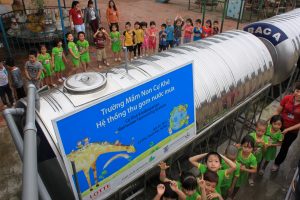Can Alternative Water Resources Become Viable in Low-Income Countries?
Driven by increasing water scarcity, the use of alternative water resources is becoming more common. They are viewed as key to creating more resilient and robust water supply systems, yet the technology and knowledge required to utilise alternative water resources can put them out of reach for many countries.
“Alternative” water resources are generally thought of as those using desalination, rainwater harvesting, water reuse, and even water loss reduction technology to increase the available water supply beyond traditional ground and surface water sources. These technologies are becoming more advanced and increasingly energy efficient. Innovative examples of their use can be seen in places like Korea, Australia, Europe and Middle Eastern countries; all of which have invested significantly in the success of these projects. A comprehensive overview of best practices, technologies and applications of alternative water resources is available in the form of a recently published compendium by the IWA.
Unfortunately, many of the countries with the greatest need for more reliable water supplies are without the economic means to implement the latest technologies. Many desalination and water reuse technologies are highly energy intensive, expensive and may even contribute to environmental degradation.
This presents a major barrier to low-income countries trying to increase food security, reduce water-borne illnesses and improve sanitation through an improved water supply. This is especially problematic in rural areas, which may not be connected to an energy grid or water distribution network, and where poverty levels tend to be higher than those of urban areas.
The question that many water professionals are asking is: “How can these regions improve water quality and availability without overdrawing diminishing natural sources, causing irreparable environmental damage or burdening themselves with debt and high operational costs?”
Achieving a perfect balance is no easy feat, but an increasing number of developing countries are creating and implementing approaches to water management that diversify water sources and incorporate alternative water resources. These approaches may differ greatly from those in the developed world, but still have the power to create robust solutions that benefit local populations.
Using alternative water resources to enhance water supply resilience does not necessarily require the most current technologies. Finding solutions that work for the location, and that can be maintained in the long-term, is more important. High-tech solutions have the potential to hurt communities more than they help; even where capital can be raised to build a state-of-the-art facility, without a steady income stream to maintain the system the initial investment may be wasted. In the case of desalination, for example, environmental and energy costs can sometimes outweigh the benefits, creating an unsustainable solution to water shortage.
Examples of alternative water resources that low-income countries have taken advantage of can be seen all over the world. In India, water-related challenges include contaminated surface water, dry season shortages and poor sanitation.
In rural Madhya Pradesh province, a small-scale rural greywater reuse system was implemented. It used a settling tank, a series of sand filters and natural aeration to treat greywater to a quality at which it could be used for toilet flushing, cleaning and garden watering. The system had a simple design and was made with locally available materials, making it accessible to even the poorest communities. The system was so effective in reducing water demand and improving sanitation that similar systems were later implemented to serve over 300 schools and 1,500 households[i].
The village of Cukhe, on the outskirts of Hanoi in Vietnam, took a different approach when arsenic contamination in the groundwater and sewage-contaminated surface water forced members of the village to buy expensive bottled water. Working with a team from Seoul National University, they installed rainwater harvesting systems consisting of screens, settling tanks with calm inlets, UV filtration and first flush systems. The collected water is of potable quality, and each system costs less than US$400, delivering significant savings on bottled water. The village uses less-trusted groundwater to meet outdoor and non-potable needs, thus diversifying its water supply and conserving rainwater[ii].
No matter the GDP of a country, having one or more alternative sources of water can improve numerous development indicators. Alternative water resources can be an important part of creating a sustainable water supply anywhere in the world, and with the Earth’s natural freshwater supply under strain, the sooner we as a society realise their true value, the better.
For more on IWA’s work in this area visit the Alternative Water Resources Cluster page
[i] Godfrey, S., Labhasetwar, P., Wate, S., and Jimenez, B. (2010). Safe greywater reuse to augment water supply and provide sanitation in semi-arid areas of rural India. Water Science & Technology, 62(6): 1296-1303.
[ii] Nguyen, D. C., Dao, A. D., Kim, T., and Han, H. (2013). A Sustainability Assessment of the Rainwater Harvesting System for Drinking Water Supply: A Case Study of Cukhe Village, Hanoi, Vietnam. Environmental Engineering Research, 18(2): 109-114.


